How To Care For Re-blooming Daylilies
Daylilies are beautiful flowers that can add a really colourful and eye-catching touch to any garden. As the name suggests, these flowers only bloom for one day, but because most of them produce new buds they continue to bloom over the course of spring and part summer. There are a number of daylily varieties that are popular because of their ability to re-bloom. Making sure that you care for these daylilies properly, will help to aid the re-blooming process and will ensure that you get to, continue enjoying the natural beauty and stunning effects of these plants in your outdoor areas.
Steps to Care for Re-blooming Daylilies
It is important to ensure that you take the necessary steps to properly care for re-blooming daylilies, as this can have an impact on their ability to re-bloom properly. You can encourage re-blooming with most daylily varieties simply by making sure that they are cared for properly. Some of the steps you should take in order to do this include:
Growing Conditions: You should ensure that the daylilies are planted in a bed that is properly drained and has a two inch layer of compost added before they are planted. Make sure the area you choose receives around six hours of sunlight or which is able to benefit from the morning sunshine coupled with light shade in the afternoons. This can help to encourage high quality blooms.
Hydration: While daylilies are not high maintenance plants, they do need to be kept hydrated especially in the spring in order to help with re-blooming in the autumn. You should therefore make sure that the soil is soaked in water once weekly during the growing season – the top six inches of soil should be kept moist. If the soil is allowed to completely dry out, the re-blooming of the plants may be prevented.
Retaining Moisture: By using a two inch layer of mulch to cover the soil you can help to retain moisture and will also help in the prevention of weed growth. This means that the daylilies will not have to compete for moisture with weeds and will therefore be able to benefit from the necessary nutrients for re-blooming.
Using Fertiliser: In the spring when the plants first begin growing, you should use a slow release, low nitrogen fertiliser between the daylilies. Sprinkle this around six inches from the plant bases and follow instructions on the fertiliser packaging with regards to application. Once you have applied the fertiliser you should water the area right away so that the nutrients can be soaked up by the plants.
Pruning: As soon as old blossoms start wilting on the plants, make sure you prune them, as this can further encourage re-blooming and growth. Once foliage dies off naturally in the winter, if you cut it back to the ground this can weaken your daylilies, preferably remove any severely damaged or dead leaves.
Making sure you take these steps and properly care for your daylilies will help to ensure you get to enjoy the beauty of these plants for far longer.

